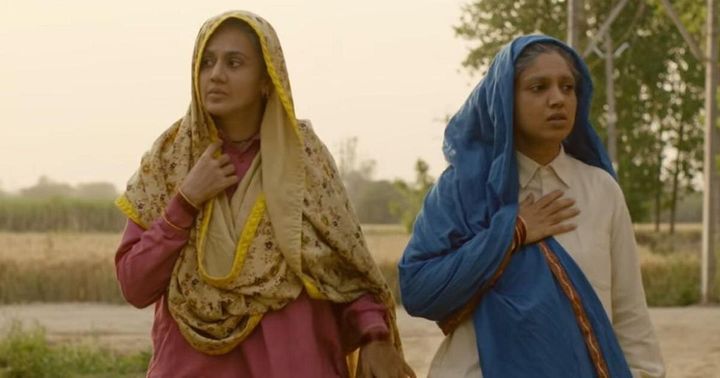
About midway through Tushar Hiranandani’s, Saand Ki Aankh which is inspired by the story of Chandro (Bhumi Pednekar) and Prakashi Tomar (Taapsee Pannu), octogenarians, sharpshooters and sisters-in-law, hailing from a small village in Uttar Pradesh, we are informed about the possible edge that the two elderly women have over their competition and how they manage to hit a bullseye almost every single time.
Decades of toiling at the farm, rearing cattle, and slogging it out under the sun has resulted in their hands having both, strength and balance, fairly uncommon for those who haven’t had the same ex. This is shown by an accompanying shot where the wrists of a bunch of passengers on a bus lose grip while the two women hold firmly hold on to the handles.
The scene tries to add some perspective to the consistent and unchallenged prowess of these two women in the sport of sharpshooting, which forms the focus of the film. Interestingly, it also feeds the film’s running subtext - about the hidden capability and resolve of these women which is permanently veiled by their place on the societal food chain and further suppressed by the men around them. This secondary narrative of the film is the one which keeps Saand Ki Aankh alive as it flows from beat to predictable beat.
The film follows two unlikely sporting champions who discover their uncanny knack for sharpshooting while trying to train their daughters to do the same. The women live in a deeply conservative household, commanded by the family patriarch and village sarpanch, Rattan Singh Tomar (a pretty serviceable Prakash Jha, in all his nostril-flared glory). He is the kind of guy who’d rather kill the women of his family than let them experience freedom. As they continue to breach archaic norms, practice and start touring the country for shooting tournaments, the women must lie to their family and negotiate the patriarchal environment with the same skill they use to hit the bull’s eye.
Of course the central conflict of the film is seen from a mile off, and even while Saand Ki Aankh takes its own meandering time to get there, what’s essential is what is said about it. The film comes to a climax after a dramatic outburst that it had been saving for the climax, but what it represents is more important than how it pans out. Drawing upon Mother India as a constant influence, the film treats its two leading ladies with reverence, depicting them as fearless, broad-minded grandmothers unafraid to pull the trigger for what’s right and yet they are also shown being constantly pressured under the burden of patriarchy.
At its heart, Saand Ki Aankh, is a film that takes on a rather simplistic storyline and attempts to make the best of it. But the subject matter is unfortunately so one-tone that all the cinematic visual drama of its central sport comes from the women arching their hand in slow motion as they take aim before shooting. There is absolutely no foil to their sharpshooting superpowers. And that makes for a problematic sports drama which spends much of its runtime scurrying from championship to championship.
The weight of the film is therefore lugged by its overlying message: of liberation in the face of overwhelming oppression, a problem so deeply entrenched within the social fabric of the country that having Chandro and Prakashi defy and demolish it serves as a bigger and more satisfying victory than any championship could ever be.
Add to that the film’s topnotch performances by Bhumi Pednekar and Taapsee Pannu. Every scene featuring the two crackles with a seemingly organic chemistry as the two actors complement each other beautifully in every shot, with Pednekar delivering a slightly more nuanced performance.
At a time where female narratives are largely relegated to gritty and raw explorations of the urban woman, chiefly focusing on their sexual liberation, here is a film that brings together two dazzling actors to present an endlessly inspiring tale of deliverance from societal dogma.
The film’s biggest problem is its linear structure and unmotivated plot progression, which seems hurried and filled with undercooked scenes. Additionally, a confusing cinematic choice made by Hiranandani is the extensive use of sweeping shots which glide across the setting, from close-ups to extreme wides, but are eventually sped up in the edit, possibly to save time.And this happens throughout the film, giving an unsettling fast-forward motion to many of its moving shots. The result is especially jarring.
But directing woes aside, Saand Ki Aankh is a unique story that is unsurprising yet intriguing. Placed in a very apt setting and produced at a very relevant time, it’s a film that brings mainstream Bollywood flair to a subject matter historically ignored by the mainstream. And it’s definitely a rarity seeing a sports biopic which doesn’t kowtow to the republic, but rather doffs its hat to mother India herself.